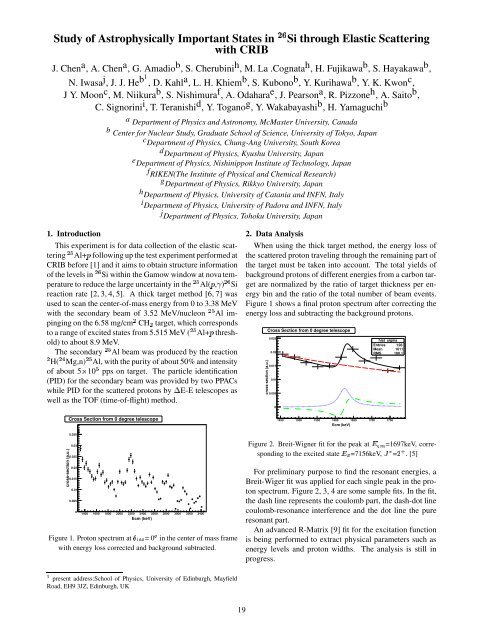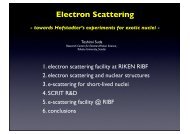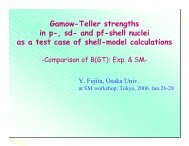Center for Nuclear Study,
Center for Nuclear Study,
Center for Nuclear Study,
Create successful ePaper yourself
Turn your PDF publications into a flip-book with our unique Google optimized e-Paper software.
<strong>Study</strong> of Astrophysically Important States in ��� Si through Elastic Scattering<br />
with CRIB<br />
J. Chen a , A. Chen a , G. Amadio b , S. Cherubini h , M. La .Cognata h , H. Fujikawa b , S. Hayakawa b ,<br />
N. Iwasaj , J. J. Heb1, D. Kahla , L. H. Khiemb , S. Kubonob , Y. Kurihawab , Y. K. Kwonc ,<br />
J Y. Moonc , M. Niikurab , S. Nishimuraf , A. Odaharae , J. Pearsona , R. Pizzoneh , A. Saitob ,<br />
C. Signorinii , T. Teranishid , Y. Toganog , Y. Wakabayashib , H. Yamaguchib a Department of Physics and Astronomy, McMaster University, Canada<br />
b <strong>Center</strong> <strong>for</strong> <strong>Nuclear</strong> <strong>Study</strong>, Graduate School of Science, University of Tokyo, Japan<br />
cDepartment of Physics, Chung-Ang University, South Korea<br />
dDepartment of Physics, Kyushu University, Japan<br />
eDepartment of Physics, Nishinippon Institute of Technology, Japan<br />
fRIKEN(The Institute of Physical and Chemical Research)<br />
gDepartment of Physics, Rikkyo University, Japan<br />
hDepartment of Physics, University of Catania and INFN, Italy<br />
iDepartment of Physics, University of Padova and INFN, Italy<br />
jDepartment of Physics, Tohoku University, Japan<br />
1. Introduction<br />
This experiment is <strong>for</strong> data collection of the elastic scattering<br />
��� Al+ � following up the test experiment per<strong>for</strong>med at<br />
CRIB be<strong>for</strong>e [1] and it aims to obtain structure in<strong>for</strong>mation<br />
of the levels in ��� Si within the Gamow window at nova temperature<br />
to reduce the large uncertainty in the ��� Al( � ,� )��� Si<br />
reaction rate [2, 3, 4, 5]. A thick target method [6, 7] was<br />
used to scan the center-of-mass energy from 0 to 3.38 MeV<br />
with the secondary beam of 3.52 MeV/nucleon ��� Al impinging<br />
on the 6.58 mg/cm� CH � target, which corresponds<br />
to a range of excited states from 5.515 MeV (��� Al+ � threshold)<br />
to about 8.9 MeV.<br />
The secondary ��� Al beam was produced by the reaction<br />
� H(��� Mg,n)��� Al, with the purity of about 50% and intensity<br />
of about 5� 10� pps on target. The particle identification<br />
(PID) <strong>for</strong> the secondary beam was provided by two PPACs<br />
while PID <strong>for</strong> the scattered protons by � E-E telescopes as<br />
well as the TOF (time-of-flight) method.<br />
cross-section (a.u.)<br />
Cross Section from 0 degree telescope<br />
0.035<br />
0.03<br />
0.025<br />
0.02<br />
0.015<br />
0.01<br />
0.005<br />
0<br />
1400 1600 1800 2000 2200 2400 2600 2800 3000 3200 3400<br />
Ecm (keV)<br />
Figure 1. Proton spectrum at � � ��� = 0 � in the center of mass frame<br />
with energy loss corrected and background subtracted.<br />
present address:School of Physics, University of Edinburgh, Mayfield<br />
�<br />
Road, EH9 3JZ, Edinburgh, UK<br />
19<br />
2. Data Analysis<br />
When using the thick target method, the energy loss of<br />
the scattered proton traveling through the remaining part of<br />
the target must be taken into account. The total yields of<br />
background protons of different energies from a carbon target<br />
are normalized by the ratio of target thickness per energy<br />
bin and the ratio of the total number of beam events.<br />
Figure 1 shows a final proton spectrum after correcting the<br />
energy loss and subtracting the background protons.<br />
cross-section (a.u.)<br />
Cross Section from 0 degree telescope<br />
0.025<br />
0.02<br />
0.015<br />
0.01<br />
0.005<br />
0<br />
hist_sigma<br />
Entries 128<br />
Mean 1611<br />
RMS 100.1<br />
1450 1500 1550 1600<br />
Ecm (keV)<br />
1650 1700 1750<br />
Figure 2. Breit-Wigner fit <strong>for</strong> the peak at � ��� =1697keV, corresponding<br />
to the excited state � � =7156keV, ��� =� � . [5]<br />
For preliminary purpose to find the resonant energies, a<br />
Breit-Wiger fit was applied <strong>for</strong> each single peak in the proton<br />
spectrum. Figure 2, 3, 4 are some sample fits. In the fit,<br />
the dash line represents the coulomb part, the dash-dot line<br />
coulomb-resonance interference and the dot line the pure<br />
resonant part.<br />
An advanced R-Matrix [9] fit <strong>for</strong> the excitation function<br />
is being per<strong>for</strong>med to extract physical parameters such as<br />
energy levels and proton widths. The analysis is still in<br />
progress.





